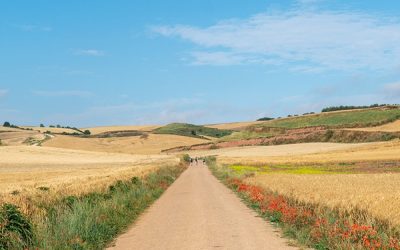An introduction to The Way of St Francis (Via di Francesco)
The Way of St Francis (Via di Francesco) connects places and paths associated with the saint, allowing walkers to see why St Francis of Assisi loved the land. The route described in the guidebook, from Florence to Assisi and Rome, takes in the solitude of mountainous green areas, medieval hill towns, sweeping vistas and ancient olive gloves. The Way of St Francis offers the perfect Italian escape for pilgrims looking for alternatives to popular routes like the Camino de Santiago.
The Way of St Francis: Via di Francesco
From Florence to Assisi and Rome
£18.95
Guidebook to walking The Way of St Francis pilgrimage trail in Italy. This 518km route from Florence, through Assisi and then to Rome and the Vatican City explores Tuscany and Umbria. Described in 27 stages, the guide to the month-long route includes detailed maps, profiles and accommodation and facilities on route. The trail visits major sites and towns famous for their connection to Italy's...
More information
Where does the Way of St Francis start and end?
The guidebook describes the route from Florence to Assisi and Rome, from north to south. However, there are alternative options, such as beginning at Santuario della Verna, one of the most scenic sections of the route, or in Assisi. Walking from Rome northbound towards Assisi is not impossible, but very few pilgrims opt for this route.
How long is the route?
The Way of St Francis from Florence to Rome is 517.6km. This is shorter than the popular Camino Portugues by over 100km.
How many days does it take to walk?
It is possible to walk the 27-stage route in 27 days, but this doesn't allow time to explore the beautiful towns and cities of Florence, Assisi, and Rome. A realistic itinerary that allows for extra days in these destinations would be around 31 - 32 days. However, there are two stages with significant elevation changes, which you may want to break down into shorter days. Overall, the route could take between 27 and 35 days, depending on your hiking experience.
When is the best time of year to walk?
April to June and mid-August to October are the best times to walk the Way of St Francis. This is when average rainfall is at its lowest, and temperatures are usually mild to hot. The highest temperatures typically occur in July and August, so these months are best avoided unless you're ready for walking in very hot temperatures. The highlands' winter climate also makes walking the route from November to March unwise as there is often snow or heavy rain on parts of the route, and the shorter days mean less time for walking.
How do you get to the start?
Florence's international airport (FLR - Florence/Perteola, Aeroporto Amerigo Vespucci) can be reached from many European destinations, including the UK. Those wishing to start at Assisi can take a train from Florence or Rome to the nearest station: Santa Maria Degli Angeli. From the station, it is either a 2.5km walk uphill to Assisi, or there is a bus every 30 minutes. Alternatively, Aeroporto San Francesco d'Assisi serves both Perguia and Assisi. However, the local bus is somewhat unreliable, and it is often more convenient to pay for a taxi, albeit more expensive.
What accommodation is available?
There are many different accommodation options on the Way of St Francis. Daily listings are included in the guidebook that detail low-cost hotels, agriturismi (farm accommodations), foresterie (guest houses) and hostels where available. Unlike the Camino de Santiago, however, pilgrims are expected to book ahead at least 2-3 days in advance of the stay. Camping is possible and is legal in designated campgrounds in Italy, but this means carrying extra weight.
Can you get luggage transfers?
Luggage services are available if you don't fancy carrying your baggage along the trail. However, given the smaller population of pilgrims walking this route, there are fewer options than other pilgrim trails, which are often more expensive. You can expect to pay 50 euros to transfer your baggage from one stage to the next, so this is more economical when done in groups. Transfers can be arranged from Florence to Assisi through Beppino,whilst Assisi to Rome is covered by Bags Free.
How do you get a pilgrim passport?
Walkers should secure their pilgrim credentials - a pilgrim identity card - within two months of departure. Pilgrims need credentials to receive the official certificate at the end of the walk. These can be ordered pre-departure from the PiccolAccoglienza of the Diocese of Gubbio, who volunteer alongside the Credentials Office to offer free credentials to pilgrims. They ask for a small donation to cover postage costs. You can also secure credentials from the Pilgrim Office in Assisi or the St James Episcopal Church in Florence.
Top tips for hiking in Italy
- Italy has a state-owned public postal service, Postal Italiane, with offices throughout towns and cities—perfect for sending home a postcard! Plus, there are usually ATMs outside.
- Often, accommodation must be booked over the phone, so having international coverage or an Italian SIM is useful. Italy's country code is +39; however, unusually, Italian phone numbers vary in length from eight to eleven digits.
- Businesses and stores close in the afternoon for the riposo - the mid-afternoon rest to avoid the worst of the sun. They typically close at 1:30 pm and reopen around 4:30-5:30 pm.
- Take some soap and a small washing line with you. While large cities have laundromat services, a sink is the most reliable way to wash clothes.
- While English is spoken in tourist centres, in smaller towns and villages along the route, little to no English is spoken. It is worth learning a few helpful phrases.













